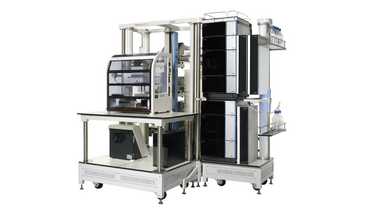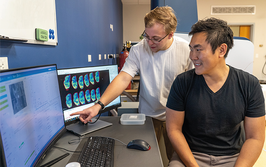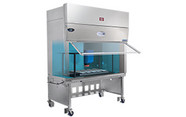Automation: No Mere “Trend”
Automation represents a fundamental transformation of the analytical lab. Here’s what you need to know to keep pace.
Dean Mulyk | | 7 min read
sponsored by Thermo Fisher Scientific

In the analytical lab (and even in our professional and personal lives), there’s a constant pressure to be more productive – with technology helping us accomplish increasingly ambitious goals. Automation has become a major trend thanks to its ability to meet demands for increased efficiency, reproducibility, and overall accuracy. But I’d argue that “major trend” doesn’t quite capture the extent to which automation, alongside AI and machine learning, is fundamentally transforming the lab.
Ultimately, automation allows scientists to focus on data – analyzing, interpreting, and planning for the next steps – rather than spending time on repetitive manual tasks. Another major advantage is reduced exposure to hazardous chemicals and potentially dangerous samples. It also enables walkaway time. Human beings are great, but we like to go home at night, spend time with family or pets, or occasionally get some rest. Robots, on the other hand, don’t mind working through the night.
Human beings also pipette slightly differently from each other or sometimes let samples sit a little longer. Some of these differences may not significantly impact results, but when you scale up – for example, in a contract research organization where 20 people are working on a study – human-induced variation accumulates. That can lead to relatively large Z-scores, making it harder to interpret data.
Automation removes much of this variability. When you’re using the same devices and following a pre-set process, every step – timing, sample handling, and execution – remains highly consistent, which leads to more precise and more reproducible data. Automated systems also ensure proper device calibration and process standardization, further reducing variability. Importantly, the resulting higher-quality data is easier to analyze, interpret, and use for decision-making.
Another significant benefit of automation is the reduction of rework, which is almost unavoidable in the manual world of errors and inconsistencies. Rework not only consumes additional consumables and valuable technician time, but also extends project timelines and strains other resources. By eliminating rework, automation accelerates project timelines, creating additional capacity within the organization for more projects and enabling scientists to ask broader, more complex questions.
The state of play
Over the years, chromatography data systems have made great strides in managing instruments, storing data, and improving efficiency. However, the current trend in technology adoption lies in addressing bottlenecks: is it sample preparation, before the prepared sample even reaches the HPLC? Or is the real challenge in data analysis – reviewing trace files and interpreting results? This varies from lab to lab and depends on the equipment they have. In other words, the field is in transition.
In reality, many (if not most) HPLC systems today are still operated manually, despite the desire to shift toward automation. Newer HPLC systems, such as the Thermo Scientific™ Vanquish™ HPLC Systems, are designed to integrate with automation. These can be paired with robotic systems to load sample plates or vial racks automatically – in fact, the Thermo Fisher Scientific Lab Automation team has integrated a wide variety of devices, including dedicated benchtop robots, dispensers, washers, liquid handlers, sealers, de-sealers, and peelers, to create comprehensive solutions. These robotic systems can automate loading preprepared sample plates or vial racks to HPLC instrument loading thru to complete end-to-end workflows that automate the entire process from sample preparation to detection.
We are seeing significant growth in automation in pharmaceutical and biopharmaceutical labs, particularly with large-molecule workflows. These fields require high-throughput workflows that incorporate both sample preparation and detection. For them, automation is about maximizing instrument utilization – keeping HPLCs and mass spectrometers running 24/7 to maximize return on investment.
Data analysis is another major focus. Many labs are already leveraging AI to assist in reviewing trace files and making sense of large datasets. The importance of AI in addressing data harmonization and analysis cannot be overstated, as it significantly enhances the accuracy and efficiency of data interpretation. Currently, AI tools and digital assistants are being developed to help users operate instruments more effectively. These advancements are expected to be widely adopted by organizations within the next two to three years, providing lab technicians with real-time guidance, optimizing equipment usage, and streamlining workflows. This will ultimately improve productivity and reduce the likelihood of human error.
The gains can be substantial. For example, one pharmaceutical lab integrated a Thermo Fisher robotic sample handling and data management system, which allowed them to reduce sample processing time by about 50 percent. Such meaningful efficiency gains really can accelerate innovation and discovery. Another lab saw around a 30 percent increase in throughput alongside a significant decrease in human error – improvements that not only boosted productivity but also enhanced data reliability. For other labs, compliance is a key driver. One lab, for example, implemented automation specifically to streamline regulatory compliance; the system provided detailed audit records and traceability, significantly easing their submission process to regulatory agencies.
Take a good, honest look at your workflow
In truth, smaller labs tend to lag in automation adoption, with initial costs and concerns about complexity making it harder to justify the investment. But these aren’t only the concerns of small labs. I’d like to remind everyone that automation tends to reduce costs in the long run – and sometimes in the short run! We worked with one customer who initially planned to conduct a study over four years, hiring six or seven additional people to handle the workload. After evaluating automation, they realized they could keep their current staff, implement an automated system, and complete the study in about 18 months. The team actually finished the study in just 14 months, largely because automation helped eliminate forecasted rework.
Some lab managers may worry that automation will reduce flexibility and adaptability. But this depends on the solution. When speaking with an automation provider, it’s crucial to ask the right questions to better understand the system’s capabilities, flexibility, and scalability. Can the system be repurposed for other workflows? Can new instruments be added later?
Finally, there’s the human element – resistance to change. And that’s why education and training is essential. Making staff part of the transition process helps build confidence and ensure they are comfortable with the new technology. The more engaged staff are, the smoother the adoption of automation into the lab’s workflow.
My advice for taking the first step: take a clear, objective look at your lab’s current workflows. Identify the areas that would benefit the most from automation. Where are the bottlenecks? Keep in mind that introducing automation may shift a bottleneck rather than eliminate it, so it’s important to think through the entire workflow. Start with incremental improvements – “quick wins.” For example, you might begin by adding an auto-loader for your HPLC system. Once that’s in place and delivering benefits, you can gradually integrate additional automation components. A phased approach helps build momentum for further adoption – but it also makes it easier to shift the lab’s focus and align automation with broader organizational goals.
Every lab’s needs are different. And that’s why we take a consultative approach – working with lab managers to understand specific bottlenecks and determine how automation can help. Whether it's improving sample handling, ensuring compliance, or enhancing data analysis, we can provide both the tools and expertise to help labs move forward with automation effectively.
For many labs, automation is a step-by-step journey that helps them evolve to meet modern demands. But given that the future of analytical chemistry is automated, isn’t it time you departed?!
Dean Mulyk, Senior Manager for Product Management within the Automation Solutions business at Thermo Fisher Scientific

















